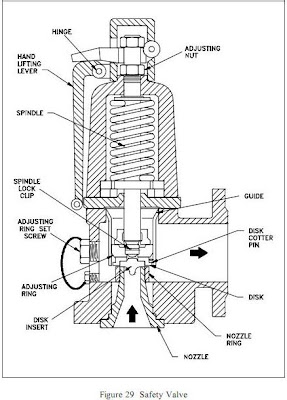
INTRODUCTION
A safety valve is a valve mechanism for the automatic release of a substance from a boiler, pressure vessel, or other system when the pressure or temperature exceeds preset limits.
It is part of a bigger set of pressure safety valves (PSV) or pressure relief valves (PRV). The other parts of the set are relief valves, safety relief valves, pilot-operated relief valves, low pressure safety valves, and vacuum pressure safety valves.
Safety valves were first used on steam boilers during the industrial revolution. Early boilers without them were prone to accidental explosion.
Vacuum safety valves (or combined pressure/vacuum safety valves) are used to prevent a tank from collapsing while emptying it or when cold rinse water is used after hot CIP or SIP. The calculation method is not defined in any norm when sizing a vacuum safety valve, particularly in the hot CIP / cold water scenario, but some manufacturers have developed simulations to do so.
Function and design
 The earliest and simplest safety valve on the steam digester in 1679 used a weight to hold the steam pressure (this design is still commonly used on pressure cookers); however, these were easily tampered with or accidentally released. On the Stockton and Darlington Railway, the safety valve tended to go off when the engine hit a bump in the track. A valve less sensitive to sudden accelerations used a spring to contain the steam pressure, but these (based on a Salter spring balance) could still be screwed down to increase the pressure beyond design limits. This dangerous practice was sometimes used to marginally increase the performance of a steam engine. In 1856 John Ramsbottom invented a tamper-proof spring safety valve that became universal on railways.
The earliest and simplest safety valve on the steam digester in 1679 used a weight to hold the steam pressure (this design is still commonly used on pressure cookers); however, these were easily tampered with or accidentally released. On the Stockton and Darlington Railway, the safety valve tended to go off when the engine hit a bump in the track. A valve less sensitive to sudden accelerations used a spring to contain the steam pressure, but these (based on a Salter spring balance) could still be screwed down to increase the pressure beyond design limits. This dangerous practice was sometimes used to marginally increase the performance of a steam engine. In 1856 John Ramsbottom invented a tamper-proof spring safety valve that became universal on railways.Safety valves also evolved to protect equipment such as pressure vessels (fired or not) and heat exchangers. The term safety valve should be limited to compressible fluid application (gas, vapor, or steam).
The two general types of protection encountered in industry are thermal protection and flow protection.
For liquid-packed vessels, thermal relief valves are generally characterized by the relatively small size of the valve necessary to provide protection from excess pressure caused by thermal expansion. In this case a small valve is adequate because most liquids are nearly incompressible, and so a relatively small amount of fluid discharged through the relief valve will produce a substantial reduction in pressure.
Flow protection is characterized by safety valves that are considerably larger than those mounted in thermal protection. They are generally sized for use in situations where significant quantities of gas or high volumes of liquid must be quickly discharged in order to protect the integrity of the vessel or pipeline. This protection can alternatively be achieved by installing a high integrity pressure protection system (HIPPS).
For more info...
IMPORTANCE:..
Safety Valves are the most important fittings on the boiler. They should open to release pressure when pressure inside the boiler exceeds the maximum allowable working pressure or MAWP. Safety valves are installed at the highest part of the steam side of the boiler. No other valve shall be installed between the boiler and the safety valve. Safety valve capacity is measured for steam that can be discharged per hour. The safety valve will remain open until sufficient steam is released and there is a specific amount of drop in pressure. This drop in pressure is the blow-down of the safety valve. Safety valve capacity and blow-down is listed on the data plate on the safety valve. Spring-loaded safety valves are the most common safety valves. A spring exerts pressure on the valve against the valve seat to keep the valve closed. When pressure inside the boiler exceeds the set popping pressure, the pressure forces the valve open to release. The ASME Code specifies the design, materials and construction of safety valves. The number of safety valves required and the frequency and procedures for testing safety valves is also specified by the ASME Code. Adjustment or repairs to safety valves must be performed by the manufacturer or an assembler authorized by the manufacturer.
Water fittings and accessories control the amount, pressure and temperature of water supplied to and from the boiler. Water in the boiler must be maintained at the normal operating water level. Low water conditions can damage the boiler and could cause a boiler explosion. High water conditions can cause carryover. Carryover occurs when small water droplets are carried in steam lines. Carryover can result in water hammer. Water hammer is a banging condition caused by hydraulic pressure that can damage equipment.








0 comments:
Post a Comment